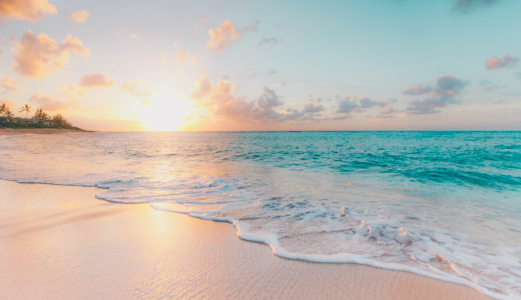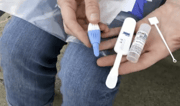A hidden danger at the shore? What’s raising concerns this summer
- Replies 0
Summer is here—and with it, beach days, seafood feasts, and long afternoons in the sun.
But before you dive into warm coastal waters or slurp down raw oysters, there’s a hidden danger you need to know about: a fast-acting, life-threatening “flesh-eating” bacteria.
This isn’t clickbait or urban legend. Real people—moms, dads, grandparents, even children—have faced devastating consequences after a day at the beach or a seafood dinner.
So here’s what you really need to know to stay safe this summer.
Within hours, Richard’s foot was swollen and blistered. Fever and chills followed. When he arrived at the ER, doctors rushed him to ICU, fighting to save his life. They told him he had a 20% chance of survival with medication alone.
The alternative? Amputation.
Richard chose to lose his leg, and after weeks of rehab, he learned to walk again with two canes. These days, he still fishes—but safely from the shore.

It doesn’t take a gaping wound to get infected. A papercut, mosquito bite, or nick from shaving can be enough. Once inside the body, the bacteria release toxins that kill tissue, suppress the immune system, and can cause sepsis—a deadly systemic infection.
Symptoms can develop within hours and include:
Also read: Fresh scents, hidden risk? This everyday essential may pose a safety concern
Cornell Arceneaux, also from Baton Rouge, survived three encounters with the bacteria: twice from handling raw shellfish with small hand cuts, and once from eating raw oysters. One of his infections required emergency surgery within hours to prevent permanent damage.
Then there’s Laura Barajas, a 40-year-old mother from San Jose, California. After eating undercooked tilapia she prepared at home, Laura developed a massive Vibrio infection. Within days, she was in a medically induced coma, her kidneys failing, her limbs turning black.
Doctors performed a quadruple amputation to save her life. Laura survived—but her life, and her family’s, is forever changed.
Also read: Holiday hotspots hiding a troubling health risk—Could this ruin your vacation?
What’s driving the surge?

Have you or someone you know had a brush with a waterborne illness? Do you have safe seafood cooking tips or beach safety hacks? Share your stories in the comments below—your experience could protect someone else.
But before you dive into warm coastal waters or slurp down raw oysters, there’s a hidden danger you need to know about: a fast-acting, life-threatening “flesh-eating” bacteria.
This isn’t clickbait or urban legend. Real people—moms, dads, grandparents, even children—have faced devastating consequences after a day at the beach or a seafood dinner.
So here’s what you really need to know to stay safe this summer.
A day at the beach turns into a nightmare
Take the story of Richard Empson, a 78-year-old grandfather from Baton Rouge, Louisiana. In 2016, he was enjoying a family vacation in Bay St. Louis, Mississippi, wading in the warm Gulf waters and fishing—something he’d done for years. But this time, a microscopic break in his skin gave Vibrio vulnificus a way in.Within hours, Richard’s foot was swollen and blistered. Fever and chills followed. When he arrived at the ER, doctors rushed him to ICU, fighting to save his life. They told him he had a 20% chance of survival with medication alone.
The alternative? Amputation.
Richard chose to lose his leg, and after weeks of rehab, he learned to walk again with two canes. These days, he still fishes—but safely from the shore.

Real people, moms, dads, grandparents, even children, have faced devastating consequences after a day at the beach or a seafood dinner. Image Source: Sean Oulashin / Unsplash
The fast and furious attack of Vibrio
Vibrio vulnificus is a bacterium that naturally thrives in warm, brackish waters, like those along the Gulf Coast. But with climate change raising ocean temperatures, it's now appearing in places it never did before, from the Northeast US to parts of Europe.It doesn’t take a gaping wound to get infected. A papercut, mosquito bite, or nick from shaving can be enough. Once inside the body, the bacteria release toxins that kill tissue, suppress the immune system, and can cause sepsis—a deadly systemic infection.
Symptoms can develop within hours and include:
- Swelling, redness, and pain at the site
- Blisters or skin ulcers
- Fever and chills
- Nausea, vomiting, or diarrhea (if ingested)
Also read: Fresh scents, hidden risk? This everyday essential may pose a safety concern
Not just a swimmer’s risk: Raw seafood can be deadly
Vibrio vulnificus doesn’t just lurk in seawater—it also thrives in raw or undercooked seafood.Cornell Arceneaux, also from Baton Rouge, survived three encounters with the bacteria: twice from handling raw shellfish with small hand cuts, and once from eating raw oysters. One of his infections required emergency surgery within hours to prevent permanent damage.
Then there’s Laura Barajas, a 40-year-old mother from San Jose, California. After eating undercooked tilapia she prepared at home, Laura developed a massive Vibrio infection. Within days, she was in a medically induced coma, her kidneys failing, her limbs turning black.
Doctors performed a quadruple amputation to save her life. Laura survived—but her life, and her family’s, is forever changed.
Also read: Holiday hotspots hiding a troubling health risk—Could this ruin your vacation?
Why are Vibrio infections on the rise?
Though still relatively rare, Vibrio infections are increasing. The CDC estimates 150–200 US cases per year, with a 20% fatality rate. A review of CDC data from 1988 to 2018 shows that Vibrio wound infections on the East Coast have increased eightfold.What’s driving the surge?
- Warming oceans from climate change
- More people recreating in coastal waters
- Higher consumption of raw or undercooked seafood
Who’s Most at Risk?
While anyone can contract a Vibrio infection, these groups are most vulnerable:- People with weakened immune systems (e.g., diabetes, liver disease, cancer)
- Older adults
- Those with chronic wounds or skin conditions
- Anyone who handles or consumes raw seafood
How to stay safe this summer
The good news? A few smart habits can dramatically reduce your risk:- Cover any cuts or scrapes before swimming in warm salt or brackish water. Waterproof bandages are your best friend.
- Shower or rinse off after swimming, especially if you have skin abrasions.
- Wear gloves when handling raw seafood, and wash your hands thoroughly afterward.
- Cook seafood fully. No raw oysters or undercooked fish—especially if you’re in a high-risk group.
- Seek immediate medical help for any swelling, redness, or pain after water or seafood exposure. Mention your recent activity—it can save your life.
Key Takeaways
- Vibrio vulnificus, a fast-acting flesh-eating bacterium, is increasingly found in warm coastal waters and raw seafood.
- Infections can enter through tiny skin breaks or ingestion, causing sepsis, tissue death, and sometimes requiring amputation within 24–48 hours.
- Cases are rising due to climate change and warming ocean waters, expanding the bacteria’s habitat into formerly cold regions.
- Those with weakened immune systems, open wounds, or who consume raw seafood are especially at risk.






